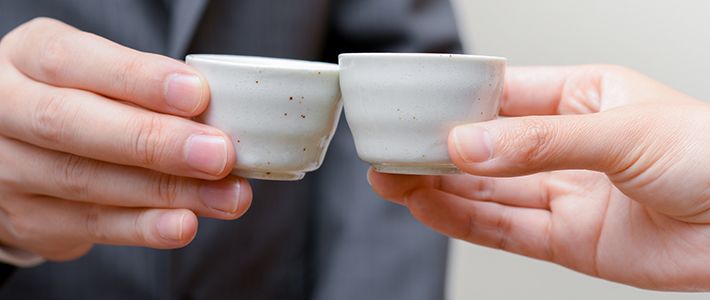
Lawmakers Raise a Cup to Local Sake
Politics Society- English
- 日本語
- 简体字
- 繁體字
- Français
- Español
- العربية
- Русский
A legislation movement encouraging the use of local sake and other drinks for toasts at official functions is gaining traction in municipalities throughout Japan. Most of these kanpai ordinances, named after the Japanese equivalent of “cheers,” have been passed following proposals from members of local assemblies, helped along by competition among local governments to establish a “brand” for themselves in a difficult financial climate. Although it’s hard to deny that there has been something of a glut of such initiatives recently, they have had a positive impact, making assembly members less reluctant to introduce bills.
From Kyoto Beginnings
The first of the kanpai ordinances came in January 2013, when the Kyoto City Assembly passed the Promotion of Kyoto Sake Ordinance. The aim was to promote “deeper understanding of traditional Japanese culture” by encouraging people to toast with sake instead of beer or champagne. The four-article-ordinance does not contain any penalties for not using sake. Instead, it urges people in the sake business to be more proactive in popularizing the drink and encourages local residents to lend their support. The assembly was spurred into passing the law by sake brewers in the city’s Fushimi ward, a sake heartland.
When the novelty of the Kyoto ordinance drew considerable media attention, other places famous for their sake rushed to follow suit, including the cities of Katō and Miki (both in Hyōgo Prefecture), situated in an area famous for producing the Yamada-nishiki rice strain favored by many sake breweries. According to the JSS, the Japan Sake and Shōchū Makers Association, by the middle of January fully 22 administrative bodies had adopted similar kanpai ordinances in support of local producers.
A noticeable development is the range of ordinances being passed. In Kyushu, the heartland of shōchū, there are laws pushing the distilled beverage in Ichikikushino, Kagoshima Prefecture, and Nichinan, Miyazaki Prefecture. In Furano, Hokkaido, the focus is on local wine. Tokoname in Aichi Prefecture has taken a different approach, encouraging people to enjoy local brews from cups made in the city’s famous ceramics style. The JSS says at least 45 governments have passed similar legislation in an attempt to create wider markets for local brands.
Legislating Individual Taste?
Not everyone approves of the way these ordinances seem to legislate matters of taste, even if there are no penalties for ignoring them. In some areas local governments have shelved bills on these grounds, in spite of petitions supporting the proposals from sections of the local communities. Mayors and governors have sometimes been reluctant to take the lead, afraid of being seen to impose their own individual preferences. As a result, most bills of this kind have been introduced by local assemblies.
One reason why these laws have spread so fast in spite of such concerns is the undeniable appeal that they have for governments suffering from revenue shortfalls. Local governments around the country have been engaged in an increasingly fierce PR battle over the past six years or so. On the frontlines of this battle are the fluffy promotional mascots that have proliferated at an astonishing rate over the past few years. One of the most successful of these mascots is Kumamon, a friendly black bear who has become a national celebrity and even performed for the Emperor and Empress late last year. Kumamon’s phenomenal success is reckoned to have raked in some ¥120 billion for Kumamoto Prefecture in just two years. Many local governments understandably see the kanpai ordinance movement as a heaven-sent opportunity to gain some cheap media exposure and raise their localities' profiles.
A New Trend of Bills From Assembly Members?
One important consequence of the movement is the effect it has had in terms of encouraging ordinary members of local assemblies to introduce bills.
Local governments throughout Japan have passed basic ordinances for assemblies to encourage them to hold public briefing sessions and enliven debate in the assemblies themselves. These steps are being taken as part of reforms to make local government activities more transparent to the public.
Despite this tendency, proposals relating to policy continue to be almost exclusively the preserve of mayors and governors. There are two reasons for this: in addition to the need to make prior arrangements with these leaders on budget measures, most assemblies do not have the structure in place to draw up bills. Many local assemblies, therefore, still have major hurdles to overcome before they are able to pass policy-related ordinances.
For this reason, the kanpai ordinances have played a significant role in encouraging assembly members to introduce bills. Some people might not regard these ordinances as policy-related in the strict sense of the term. Nevertheless, they should be seen as an appropriate, relatively simple way of easing politicians into this important task.
There is a danger, though, that this kind of legislation might get out of control. Nobody wants to see copycat ordinances being introduced in areas that are not particularly known for their sake at all. Assemblies should think carefully about their aims when establishing these ordinances and only take measures that fit in with their overall strategies for promoting their local brands.
Recently, assembly members have successfully proposed ambitious policy ordinances relating to disaster preparedness, suicide prevention, and vacant property measures. Will the kanpai movement combine with these efforts and prompt a wave of member-instigated bills? The answer to this question is likely to play an important part in the run-up to the next nationwide local elections, due to be held in spring 2015.
(Originally written in Japanese)